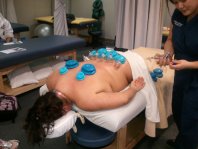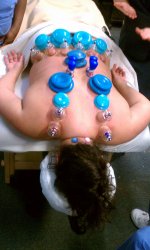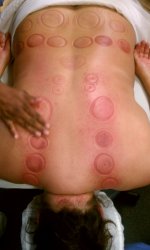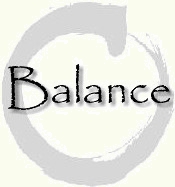cupping massage

An Ancient Practice for Enhanced Well-Being
The cupping procedure uses glass, plastic, silicon, or rubber cups which are applied to the surface of the skin. Negative pressure or a vacuum is created as air is removed from the cup and this action draws skin and flesh into the cup. This stimulates the blood circulation and the underlying musculature.
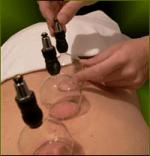
Massage cupping is ideal for performing deep tissue massage and helps to assist the soft tissue in eliminating accumulated waste products, loosen adhesions, facilitate blood flow, and stimulate the body by opening meridians. Meridians are the conduits in the body through which energy flows to every part of the body. There are meridians on the back that, when opened, allow invigorating energy to travel the whole length of the body. It has been found that cupping is a noninvasive and effective way of opening these meridians.
What to Expect
During a cupping treatment, you will experience a mild pulling sensation, which calms the sympathetic nervous system and allows a deep relaxation to move through the whole body. It is not unusual for someone to fall asleep during the treatment, waking up afterwards feeling relaxed and refreshed.
People often describe a deep warmth and/or a tingling sensation long after the treatment has ended. Cupping is not an irritant to the skin or body. It draws the inflammation out, yet does not add to it.
The entire back may be treated, including the neck, shoulders, middle and lower back, and sacral area. The hip, thigh and abdominal areas may also be treated.
Larger cups are used on the back, and a strong vacuum will mimic the rolling action of deep tissue massage without the discomfort. The movement may be long and draining or circular and stimulating for stubborn knots and areas of rigid tissue. Application of liniments, analgesics and essential oil blends immediately after the cupping will enable the absorption of the product deep into the tissue. The increased local blood supply to the muscles and skin will bring nourishment and allow for accumulated waste products to be carried away.
This procedure is relatively painless and extremely effective, after treatment people comment on have a feeling of lightness and flexibility in the formerly painful area.
Discoloration/Cup Kisses/Suction Marks/Pepperonis :)
I like to think of cupping marks as badges of healing.
As seen on swimmers at the 2008 Olympics and actress Gwyneth Paltrow, wear your 'cupping badges' proudly as signs of your quest for wellness.
Due to stagnant blood and fluid being drawn close to the skin surface, cupping can leave painless, discolored marks (red to deep purple in color) which can remain for a few days to a few weeks. More discoloration may occur in areas of stagnation, if greater negative pressure is used, or if you flush easily or have a fair complexion.
Since most cupping procedures are performed on the back or front of the torso, any resulting marks are usually in areas that are covered by clothing.

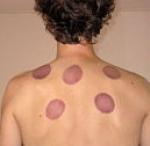
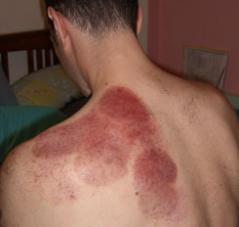
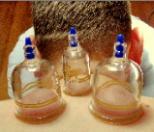

History
Cupping has been used since ancient times and was a popular practice in both Western and Eastern medicine.
The Ebers Papyrus, one of the oldest medical textbooks in the world, describes the systematic use of cupping by the early Egyptians, as far back as 1,550 B.C.
The famous Taoist alchemist and herbalist, Ge Hong (281–341 A.D.), described this method in his book A Handbook of Prescriptions for Emergencies.
